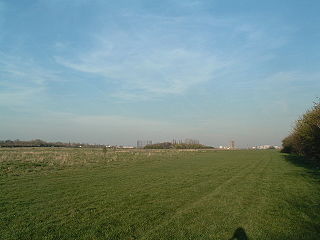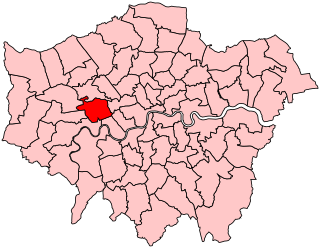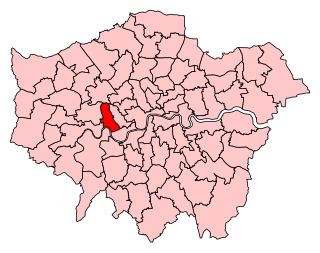
Acton is a town and area in west London, England, within the London Borough of Ealing. It is 6.1 miles (10 km) west of Charing Cross.

Wormwood Scrubs, known locally as The Scrubs, is an open space in Old Oak Common located in the north-eastern corner of the London Borough of Hammersmith and Fulham in west London. It is the largest open space in the borough, at 67 hectares, and one of the largest areas of common in London. The eastern part, known as Little Wormwood Scrubs, is cut off by Scrubs Lane and the West London line railway. It has been an open public space since the Wormwood Scrubs Act 1879.

Shepherd's Bush is a suburb of West London, England, within the London Borough of Hammersmith and Fulham 4.9 miles (7.9 km) west of Charing Cross, and identified as a major metropolitan centre in the London Plan.

The County of London was a county of England from 1889 to 1965, corresponding to the area known today as Inner London. It was created as part of the general introduction of elected county government in England, by way of the Local Government Act 1888. The Act created an administrative County of London, which included within its territory the City of London. However, the City of London and the County of London formed separate ceremonial counties for "non-administrative" purposes. The local authority for the county was the London County Council (LCC), which initially performed only a limited range of functions, but gained further powers during its 76-year existence. The LCC provided very few services within the City of London, where the ancient Corporation monopolised local governance. In 1900, the lower-tier civil parishes and district boards were replaced with 28 new metropolitan boroughs. The territory of the county was 74,903 acres (303.12 km2) in 1961. During its existence, there was a long-term decline in population as more residents moved into the outer suburbs; there were periodic reviews of the local government structures in the greater London area and several failed attempts to expand the boundaries of the county. In 1965, the London Government Act 1963 replaced the county with the much larger Greater London administrative area.

The Metropolitan Borough of Hammersmith was a metropolitan borough in London, England from 1900 to 1965. It included Hammersmith, Wormwood Scrubs, Old Oak Common and Shepherd's Bush.

Ealing, Acton and Shepherd's Bush was a parliamentary constituency represented in the House of Commons of the Parliament of the United Kingdom. It elected one Member of Parliament (MP) by the first past the post system of election. The constituency was abolished at the 2010 general election when it was divided between the new seats of Ealing Central and Acton and Hammersmith, with then incumbent Andy Slaughter becoming MP for the latter seat.

Old Oak Common is a semi-industrial area of London, between Harlesden and Acton. The area is traditionally known for its railway depots, particularly Old Oak Common TMD which was decommissioned in 2021. Together with neighbouring Park Royal, the area is intended to become the UK's largest regeneration scheme.

Hammersmith was a parliamentary constituency in the House of Commons of the UK Parliament represented from 2010 until its abolition for the 2024 general election by Andy Slaughter, a member of the Labour Party.

Tower Gardens in North Tottenham is a distinctive semi-circular estate bounded by Lordship Lane and the Roundway. Constructed between 1904 and 1928, it was one of the first municipal "cottage estates" in the world. It is now a conservation area and is featured in the annual London Open City architecture weekend held third weekend in September. Originally known as the White Hart Lane Estate, Tower Gardens was built by the London County Council (LCC) using powers granted to local authorities by the Housing of the Working Classes Act 1900. Samuel Montagu, 1st Baron Swaythling donated £10,000 for the purchase of the land on which it was built. The donation was tied to the rehousing of Jewish workers resident in the Tower Hamlets parish, and required an area of land to be set aside for public gardens: hence the name Tower Gardens. Tower Gardens was also the first LCC estate to be built outside the LCC area.
Hammersmith North was a borough constituency in the Metropolitan Borough of Hammersmith in West London. It returned one Member of Parliament (MP) to the House of Commons of the Parliament of the United Kingdom, elected by the first past the post system.

Ravenscourt Park or RCP is an 8.3 hectares public park and garden located in the London Borough of Hammersmith and Fulham, England. It is one of the Borough's flagship parks, having won a Green Flag Award. Stamford Brook and Ravenscourt Park tube stations are close by.
The North and South Western Junction Railway (NSWJR) was a short railway in west London, England. It opened in 1853, connecting Willesden on the London and North Western Railway (LNWR) with Brentford on the London and South Western Railway (LSWR). After a difficult start it became an important freight route and that usage continues today. A passenger service linked LSWR stations with the North London Railway, and a branch was built to Hammersmith.

The Garden Village is an area of model village housing built in the early 1900s, in the Summergangs area of Kingston upon Hull, England, for the workers of Reckitt & Sons.

Wormholt Park is a 7.75 acres (3.14 ha) urban park in the London Borough of Hammersmith and Fulham, near White City, Shepherd's Bush.

Totterdown Fields was the first London County Council cottage estate built between 1901 and 1911 It contained 1244 individual houses built over 38 acres (15 ha). The estate was designated a conservation area, on 19 September 1978.

The Norbury Estate originated as a London County Council cottage estate constructed between 1901 and 1920 at Norbury in what is now the north of the London Borough of Croydon. It was declared a conservation area in 2008.

Dover House Estate is one of a number of important London County Council cottage estates inspired by the Garden city movement. The land was previously the estates of two large houses, Dover House and Putney Park House, which were purchased by the London County Council soon after World War I. Dover House was demolished for the new estate, but Putney Park House remains.
The Watling Estate is in Burnt Oak, in the Edgware district of the London Borough of Barnet. It was one of twelve London County Council cottage estates built between the wars to provide "homes fit for heroes". There are 4032 homes set in 386 acres (156 ha).
Nicholas Byron "Nick" Botterill is a British businessman, company director, and Conservative politician.
















